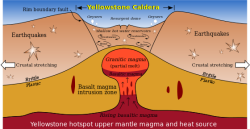
February Editorial
The Origin of the Yellowstone Supervolcano

February Editorial
The Origin of the Yellowstone Supervolcano
|
|
The Yellowstone Caldera is in Yellowstone National Park in the United States. It is sometimes referred to as the Yellowstone Supervolcano. (A supervolcano is any volcano capable of producing a volcanic eruption greater than 1015 kg in mass.) Since a supervolcano eruption is a catastrophic, civilization-endangering event, it is understandable that the Yellowstone Caldera is intensively monitored and studied. Volcanism at Yellowstone is relatively recent. The calderas were created during very large eruptions that took place at intervals 2.1 million, 1.3 million, and 630,000 years ago. Each of these was enormously destructive, and the current calderas are so huge they can only be seen from the air. According to an analysis of earthquake data in 2013, the current magma chamber of Yellowstone is 80 km (50 mi) long and 20 km (12 mi) wide. The underground mass of 4,000 km3 (960 cu mi) is 6–8% is filled with molten rock. This makes the supervolcano about 2.5 times bigger than scientists had previously imagined it to be. The good news is that scientists believe that the amount of melt in the chamber is much too low to allow another supereruption just yet. Nevertheless, understanding the complex geological processes that form supervolcanoes could ultimately help geologists determine what triggers an eruption. This is very much true for the Yellowstone volcano since its origin is still under much debate. One of the most prevalent views is that Yellowstone's supervolcano was formed by a vertical column of hot rocks rising from the top of the earth's core, known as a mantle plume. However recent studies have castdoubt on that theory. Lijun Liu, a geology professor at the University of Illinois and his co-worker, Tiffany Leonard, have created a complex computer model that replicates both the plate tectonic history of the surface and the geophysical image of the Earth's interior. "Our physical model is more sophisticated and realistic than previous studies, because we simultaneously consider many more relevant dynamic processes", Liu said. Using this sophisticated model and recent tomographic images the scientists evaluated the plume hypothesis and its interaction with Farallon slabs. (The Farallon Plate was an ancient oceanic plate that began subducting under the west coast of the North American Plate - at that time located in modern Utah - when Pangaea broke apart during Jurassic period. Over time, the central part of the Farallon Plate was completely subducted under the southwestern part of the North American Plate. The present remains of the Farallon Plate are:
This new model has allowed the scientists to study the movement of the plume and and compare it to the movement of the Farallon slabs. Their model showed that the slab was always in the way of the initial rising plume. According to the computer model, the only time when the plume could have reached the surface was around 15 Ma (million years before present) through the broken slab hinge. For the rest of the time the sinking slabs dominated the mantle flow, blocking its upwelling. Their study concluded that a plume is likely to have much less influence on the Yellowstone volcanism than previously thought. Although the new computer model negates the role of the plume in creation of Yellowstone volcano, it does not provide any new theory as to the origin of this supervolcano. In other words formation of the Yellowstone volcanic system remains a mystery, and the discovery that a plume is probably not the cause has only made the supervolcano’s origins yet more mysterious. Journal Reference: |
| _______________________________ | ||||
| Home | | | Shopping | | | Database |
© Biscuit Software 2004-2015
All rights reserved